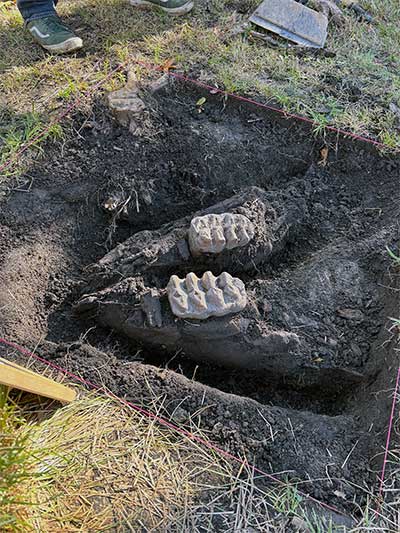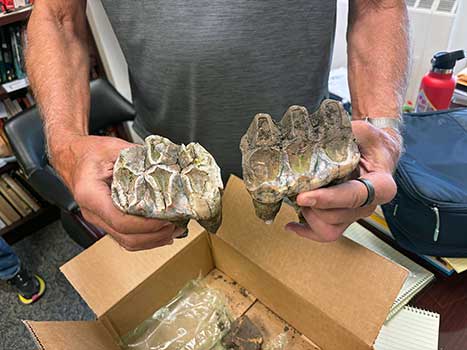Original 2024 Discovery
Background: The Fall 2024 Discovery
During the Fall of 2024, an Orange County family uncovered several unknown and unusual items from near the surface of their property, and they brought the items to SUNY Orange for assistance in determining what they might be. They first met with geology instructor Anthony Soricelli, who quickly connected them with Dr. Cory Harris, chair of the College’s Behavioral Sciences Department and a professor of anthropology and sociology. Both Soricelli and Harris were immediately able to identify the two items as mastodon teeth.
Harris put the family in touch with the New York State Museum, who sent staff to the site for further investigation. Harris joined the museum team to excavate a small area, which yielded a full mastodon jaw and some additional small skeletal remains.
“This process played out exactly as it should have, and became a true partnership between the state and the College,” Harris said. “The residents came to the College with the understanding and expectation that we could help them identify what they’d found, and we were able to connect them with the New York State Museum. They trusted us to give them the proper guidance.
This recent discovery is not SUNY Orange’s first experience with mastodon remains. Since the 1980s, the College’s Middletown campus has been the home of “Sugar,” a mastodon skeleton found in 1972 near the Warwick-Chester border that was donated to the people of Orange County by the New York State Archaeological Association. The Sugar Loaf mastodon (mastodon americanus) greets all students as they enter the Bio-Tech building’s main entrance. The skeleton belonged to a 20-foot long male that possessed an unusual tusk in the lower jaw and stood almost nine feet tall at the pelvis. “Sugar” has been radiocarbon dated at 7910 B.C. (plus or minus 225 years).
Full New York State Department of Education Release (issued Dec. 17, 2024)
A remarkable discovery in Orange County, New York, has unearthed a complete mastodon jaw, marking the first such find in the State in over 11 years.
The jaw, along with additional bone fragments, was recovered by researchers from the New York State Museum and SUNY Orange from the backyard of a residence near Scotchtown, New York. The fossils are scheduled for carbon dating and comprehensive analysis to determine the mastodon’s age, diet, and habitat during its lifetime. Following preservation and scientific analysis, the artifact will be featured in public programming in 2025.
 The mastodon jaw, which belonged to an adult individual, was found protruding from
the topsoil, capturing the homeowner’s attention and sparking an investigation that
will continue to uncover scientific insights for years to come. The discovery began
when the homeowner found two teeth concealed by the fronds of a plant on their property.
Upon further investigation, the homeowner unearthed two additional teeth just inches
underground.
The mastodon jaw, which belonged to an adult individual, was found protruding from
the topsoil, capturing the homeowner’s attention and sparking an investigation that
will continue to uncover scientific insights for years to come. The discovery began
when the homeowner found two teeth concealed by the fronds of a plant on their property.
Upon further investigation, the homeowner unearthed two additional teeth just inches
underground.
Excavation efforts by Museum and SUNY Orange staff yielded a full, well-preserved mastodon jaw belonging to an adult, as well as a piece of a toe bone and a rib fragment. This significant find will enhance our understanding of the region’s Ice Age inhabitants and highlight the abundance of prehistoric wonders yet to be discovered. With over 150 mastodon fossils found statewide to date—about one-third in Orange County—the area remains New York’s premier hotspot for these ancient relatives of modern elephants.
"The New York State Museum is proud to be home to some of the most talented scientists and researchers in the state and across the nation," said Interim Deputy Commissioner for Cultural Education, Michael Mastroianni. "As stewards of New York’s history, we are dedicated to advancing research that deepens our understanding of the state's natural legacy and ensuring our discoveries continue to inspire future generations. This discovery highlights the Museum's unwavering mission to empower vital scientific research that reveals the profound changes shaping our environment and inspiring actionable steps toward a more sustainable future."
“This discovery is a testament to the rich paleontological history of New York and the ongoing efforts to understand its past,” said Dr. Robert Feranec, director of Research & Collections and curator of Ice Age Animals at the New York State Museum. “This mastodon jaw provides a unique opportunity to study the ecology of this magnificent species, which will enhance our understanding of the Ice Age ecosystems from this region. Fossils are resources that provide remarkable snapshots of the past, allowing us to not only reconstruct ancient ecosystems but also provide us with better context and understanding of the current world around us. Each discovery like this one brings us one step closer to piecing together the full story of New York.”
“When I found the teeth and examined them in my hands, I knew they were something special and decided to call in the experts,” said the resident whose backyard safeguarded this prehistoric treasure. “I'm thrilled that our property has yielded such an important find for the scientific community.”
“While the jaw is the star of the show, the additional toe and rib fragments offer valuable context and the potential for additional research,” said Dr. Cory Harris Chair of SUNY Orange’s Behavioral Sciences Department. “We are also hoping to further explore the immediate area to see if there are any additional bones that were preserved.”
The excavation and study of the mastodon jaw are part of ongoing efforts to document and preserve the rich paleontological heritage of the state. The public is encouraged to report any similar discoveries to the appropriate authorities, as every find has the potential to shed light on the distant past and inspire new generations of scientists and enthusiasts.


